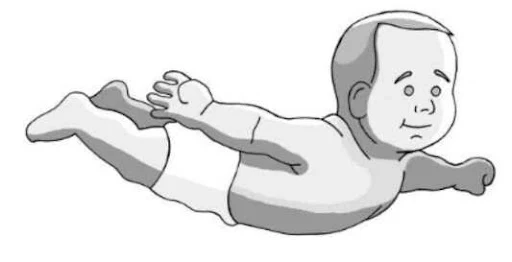Postural reflexes | Definition, types and clinical significance
Table of Content
- Definition
- General significance of postural reflexes
- What are the various postural reflexes?
- STNR • How to elicit • Duration • Clinical significance
- ATNR • How to elicit • Duration • Clinical significance
- Parachute reflex • How to elicit • Duration • Clinical significance
- Landau reflex • How to elicit • Duration • Clinical significance
- Righting reflexes
- Neck righting
- Body righting
- Tonic labyrinthine reflex
Frequently asked questions
- Theory - What are various postural reflexes and what is their clinical significance? Dec 2006
- OSCE stations - elicit a particular postural reflex and explain clinical significance. (Observed OSCE stations)
What is a postural reflex? - Definition
Postural reflexes are complex motor responses that provide automatic control of posture, balance, and coordination.
They are characterized by a certain stereotyped posture of the trunk, head, and extremities when the examiner attempts a defined and sudden change of position.
Postural reflexes replace primitive reflexes like Moro's, rooting and grasp reflex
Clinical significance of postural reflexes in general
- Postural reflexes are age-specific in normal, healthy infants.
- Severe deviations from the normal time frame may indicate neurological immaturity or dysfunction
- Thus they can help to determine the level of neurological maturation.
- if primitive postural reflexes are retained too long, they may impact natural development.
The significance of individual reflexes is explained below
What are the various postural reflexes?
Examples of postural reflexes are
- Symmetrical tonic-clonic reflex
- Asymmetric tonic-clonic reflex
- Parachute reflex
- Landau reflex
- Righting reflex
- Neck righting
- body righting
- Tonic labyrinthine reflex
Symmetrical tonic-clonic reflex (STNR)
How to elicit?
The symmetrical tonic neck reflex is elicited by flexion or extension of the neck. The symmetric tonic neck reflex is performed with the child held prone over the examiner’s knees.
Reaction
- When the neck extends, the arms extend and the lower extremities flex.
- When the neck flexes, the arm flexes and the lower extremities extend.
Appears at
Normally appears from birth to 3-4 months
Disappear at
The reflex disappears when they learn to crawl, a movement that demands independent limb movement from the position of the head, at around 1 year of age.
Clinical significance of STNR
- Normally reflex helps small infants to support the posture with arms and to get on the hands and knees.
- In cerebral palsy The reflex is overactive.
- when the head is raised, the child can only extend his arms but the legs are fixed in flexion. As long as the head is raised the child is unable to extend the legs which makes crawling difficult.
Asymmetric tonic neck reflex (ATNR)
How to elicit?
Turning head to either side in a child who is lying down on their back.

Response
When the head is turned to one side, the arm on that side flexes while the opposite arm extends. The contralateral knee is often flexed.
Appears at
Can appear as early as 18 weeks of gestation and can help facilitate vaginal delivery.
Disappear at
Normally disappears by the age of 5 to 6 months when they are learning complex motor skills.
Clinical significance
- The reflex is more marked and last longer in spastic babies.
- The reflex is partly responsible for preventing the child from rolling from
- prone to supine or vice versa.
Parachute reflex
How to elicit?
Holding the child in ventral suspension and suddenly lowering towards the couch.
Response
Arms extend as if to protect from falling, like fanning out of a parachute
Appears at
6 to 9 months
Disappears at
Persists throughout life
Clinical Significance
- In children with cerebral palsy, the reflex is absent or incomplete owing to the strong flexor tone in this position.
- In a child with hemiplegia, the reflex would be normal on the unaffected side.
Landau reflex
How to elicit?
Can be elicited by holding a child is in ventral suspension/prone in air with neck/head down.

Response
Upon holding in ventral suspension, head, spine, and legs extend like a superman. When the neck/head is flexed, the elbow, hip, and knees also flex.
Appears at
Appears by the age of 3 months
Disappears at
1 year
Clinical significance
- The absence of the reflex over the age of 3 months is seen in cases of motor weakness like a floppy infant, cerebral palsy, and children with mental sub-normality.
- Normally Landau reflex helps to increase muscle tone in the back and neck.
Labyrinthine righting reflex
Righting reflex helps to restore the normal position of the head in space and to maintain the normal postural relationship between head, trunk, and limbs during all activities.
Righting reflexes are mediated by
- Combination of vestibular inputs
- Visual input and
- Somatosensory inputs
Reflex involves various corrective actions happening in sequence to correct the orientation of the body.
Neck righting reflex
This is present at birth and is strongest at the age of 3 months. Turning head to one side is followed by movement of the rest of the body to the same side.
The body righting reflex
This appears at 7 to 12 months. When the body is turned to one side, the neck turns to the same side. It plays an important role in the child’s early attempts to sit and stand.
Tonic labyrinthine reflex (TLR)
This is really simple to understand
Forward TLR
When the neck flexes, arms and legs flex. Appear in utero, disappears at 4 months.
Backward TLR
When the neck extends backward, arms and legs extend. It appears in utero and disappears by 3 months but may last up to 3 years as well.
Clinical significance
- Righting reflexes enable the child to roll from prone to supine and supine to prone. They help him to get on to his hands and knees and to sit up.
- TLR helps in building muscle tone against gravity.
- In severe cases of cerebral palsy, the righting reflexes are absent. This prevents raising the head in the supine or prone position and great difficulty in turning over and sitting up
- In severe cases of spastic cerebral palsy, when the examiner attempts to flex the child’s head, holding the back of the head, there is strong resistance to flexion. The head might extend and the whole back may arch backward.
Footnotes
Frequently asked question is a series of solved Pediatrics theory questions. They are not alternatives to thorough textbook reading but can be used for rapid revision at the last moment and also for clinical viva.
Reference
- Best resource for Neurological exam and reflexes in infants- Videos and Descriptions (Utah university)
- Physiology of postural reflexes
Author

Shailesh Gophane | DCH DNB Pediatrics
Shailesh completed his Pediatric residency from Port Trust Hospital Mumbai after completing DCH from J.J. Hospital, Mumbai
Author

Ajay Agade | DNB(Pediatrics), FNB(Pediatric Intensive Care), Fellowship in Pediatric pulmonology and LTV
Ajay is a Paediatric Intensivist, currently working in Pediatric Pulmonology & LTV at Great Ormond Street Hospital NHS, London
💡 Join the Discussion!
🩺 Help us refine this article — share corrections or additional information below. Let's elevate the accuracy of knowledge together! 💉💬